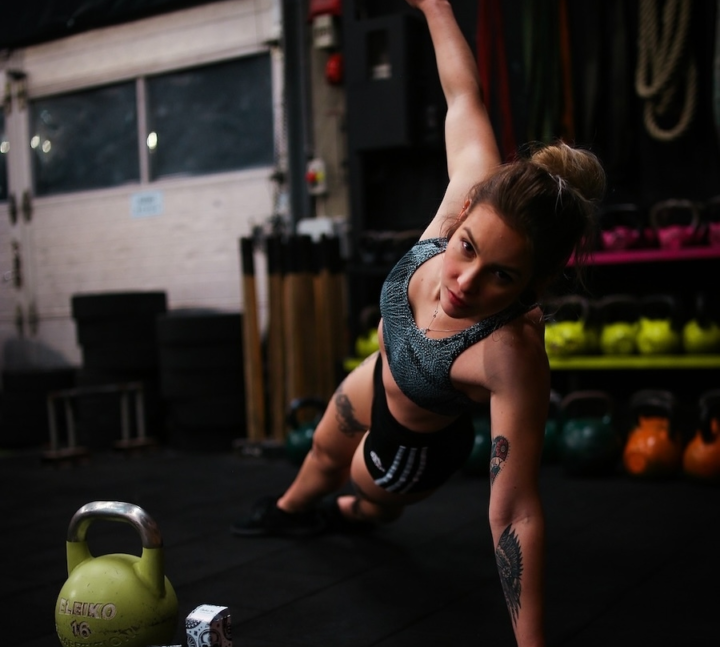Exercise
Side Plank
How to Perform - Side Plank
- Lie on your side with your legs extended and feet stacked on top of each other.
- Position your elbow directly beneath your shoulder with your forearm perpendicular to your body and hand flat on the ground.
- Contract your core muscles and lift your hips off the floor, creating a straight line from your head to your feet.
- Extend your top arm straight up toward the ceiling or place it on your hip for balance.
- Breathe normally while maintaining tension throughout your body, especially in your core and glutes.
- Keep your head in a neutral position by gazing straight ahead, not down at the floor.
- Hold this position while maintaining proper alignment and avoiding any rotation in your hips or shoulders.
- To exit the position, slowly lower your hips back to the floor with control.
Important information
- Make sure your supporting shoulder stays pulled back and away from your ear to prevent unnecessary neck strain.
- Keep your body in a perfectly straight line – avoid letting your hips sag or pike upward during the hold.
- If the standard position is too challenging, modify by bending your bottom knee and keeping that leg on the floor for additional support.
- Squeeze your glutes throughout the exercise to enhance stability and prevent lower back compensation.
Primary Muscles
Muscle Groups
Mechanic
Risk Areas
Built for progress
Take the guesswork out of training
Create personalized AI-powered workout plans that evolve with you. Train smarter, track every rep and keep moving forward, one workout at a time.






The Side Plank stands as one of the most effective isometric core exercises in any fitness arsenal, challenging your stability while specifically targeting your obliques and transverse abdominis. This intermediate-level movement delivers remarkable benefits without requiring any equipment, making it perfect for both home and gym settings.
When incorporated into your warm-up routine, the Side Plank activates your core musculature, preparing your body for more dynamic movements to follow. The exercise enhances neuromuscular connections throughout your lateral core, which can improve performance in subsequent exercises that require rotational stability.
As part of your recovery or cool-down protocol, Side Planks help reinforce proper core engagement patterns that may have been compromised during intense training. The controlled nature of this isometric hold allows you to focus on breathing techniques while maintaining tension, promoting mind-muscle connection without adding unnecessary stress to an already taxed system.
The beauty of the Side Plank lies in its ability to simultaneously challenge core endurance while building functional strength along the lateral chain. Your obliques work overtime to prevent your hips from dropping, while your rectus abdominis (six-pack muscles) engage to maintain a neutral spine position throughout the hold.
What sets Side Planks apart from traditional core exercises is the anti-rotation component, forcing your body to resist gravitational forces from an unusual angle. This translates to real-world stability benefits, particularly for athletes in rotational sports or anyone seeking to improve daily movement patterns.
Regular incorporation of Side Planks into your fitness regimen can address muscular imbalances between the left and right sides of your core, potentially reducing injury risk and enhancing overall athletic performance. The exercise serves as an excellent barometer for assessing core endurance capabilities while providing a clear progression path as your strength improves over time.
FAQ - Side Plank
The Side Plank primarily targets your obliques and transverse abdominis, while also engaging your quadratus lumborum, gluteus medius, and adductors as stabilizers. Your shoulders, particularly the deltoids, also work to maintain proper upper body alignment throughout the hold.
Beginners should aim for 20-30 seconds per side, while intermediate exercisers can target 30-60 seconds. Focus on quality over quantity - it's better to perform multiple shorter holds with perfect form than a single longer hold with compromised technique.
The most common errors include allowing your hips to sag toward the floor, rotating your torso forward or backward, and shrugging your supporting shoulder toward your ear. Maintain a straight line from head to heels, keep your body stacked vertically, and create space between your ear and shoulder.
Perform the exercise with your knees bent at 90 degrees instead of legs extended, reducing the lever length and overall difficulty. Another effective regression is placing your bottom forearm on the ground instead of just your hand, creating a more stable base of support.
Include Side Planks 2-3 times weekly as part of your core training, allowing at least 48 hours between sessions for recovery if you're performing high-intensity variations. For optimal results, alternate between left and right sides, gradually increasing hold time as your strength improves.







